
Oita Prefectural Library. Photography by Yasuhiro Ishimoto.
“The most important thing an artist can do is confront society with something it has never seen before, something in a sense improper,” Isozaki declared during his participation in the Triennale di Milano in 2004, to explain his motivations to design architecture.
His belated mention of Pritzker highlighted his "profound knowledge" of architectural theory and history and his career-long embrace of the avant-garde throughout his career, adding: "In his search for meaningful architecture, he created buildings of great quality that to this day defy categorizations, reflect his constant evolution, and are always fresh in their approach.”
Arata Isozaki was a modernist who distanced himself from the common stereotype, absorbing and reinterpreting Eastern and Western traditions, bridging the gaps between cultures and designing buildings that had timeless international appeal. He leaves behind a partner, his longtime companion, Misa Shin, of many years, his two sons and more than 100 complete works that profoundly marked the development of the profession on four continents.
In 1983, he championed an apparently unbuildable entry for a sports club in Hong Kong by the then-unknown Iraqi British architect Zaha Hadid. The daring vote launched her career.
































